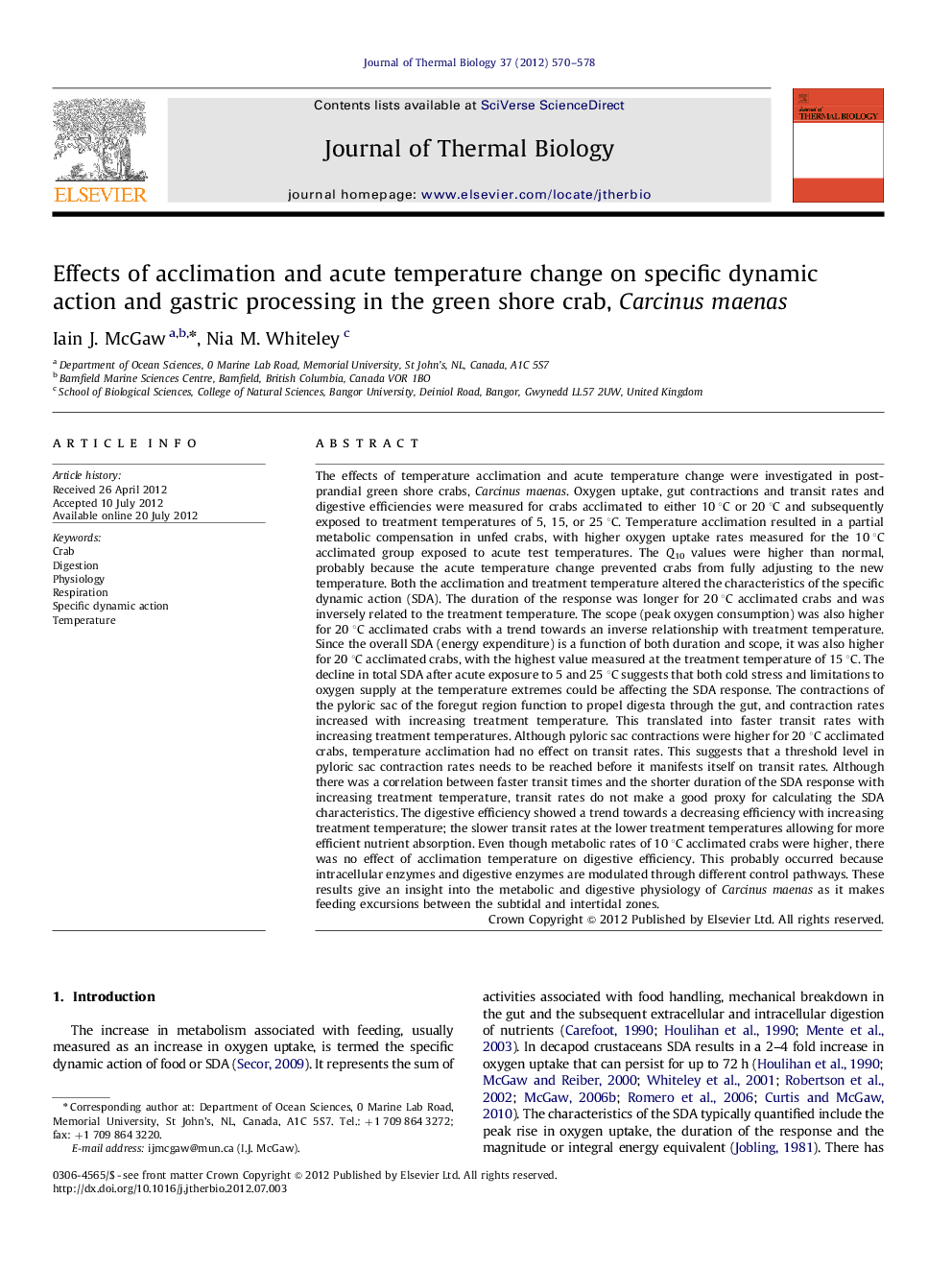| کد مقاله | کد نشریه | سال انتشار | مقاله انگلیسی | نسخه تمام متن |
|---|---|---|---|---|
| 2843111 | 1166073 | 2012 | 9 صفحه PDF | دانلود رایگان |

The effects of temperature acclimation and acute temperature change were investigated in postprandial green shore crabs, Carcinus maenas. Oxygen uptake, gut contractions and transit rates and digestive efficiencies were measured for crabs acclimated to either 10 °C or 20 °C and subsequently exposed to treatment temperatures of 5, 15, or 25 °C. Temperature acclimation resulted in a partial metabolic compensation in unfed crabs, with higher oxygen uptake rates measured for the 10 °C acclimated group exposed to acute test temperatures. The Q10 values were higher than normal, probably because the acute temperature change prevented crabs from fully adjusting to the new temperature. Both the acclimation and treatment temperature altered the characteristics of the specific dynamic action (SDA). The duration of the response was longer for 20 °C acclimated crabs and was inversely related to the treatment temperature. The scope (peak oxygen consumption) was also higher for 20 °C acclimated crabs with a trend towards an inverse relationship with treatment temperature. Since the overall SDA (energy expenditure) is a function of both duration and scope, it was also higher for 20 °C acclimated crabs, with the highest value measured at the treatment temperature of 15 °C. The decline in total SDA after acute exposure to 5 and 25 °C suggests that both cold stress and limitations to oxygen supply at the temperature extremes could be affecting the SDA response. The contractions of the pyloric sac of the foregut region function to propel digesta through the gut, and contraction rates increased with increasing treatment temperature. This translated into faster transit rates with increasing treatment temperatures. Although pyloric sac contractions were higher for 20 °C acclimated crabs, temperature acclimation had no effect on transit rates. This suggests that a threshold level in pyloric sac contraction rates needs to be reached before it manifests itself on transit rates. Although there was a correlation between faster transit times and the shorter duration of the SDA response with increasing treatment temperature, transit rates do not make a good proxy for calculating the SDA characteristics. The digestive efficiency showed a trend towards a decreasing efficiency with increasing treatment temperature; the slower transit rates at the lower treatment temperatures allowing for more efficient nutrient absorption. Even though metabolic rates of 10 °C acclimated crabs were higher, there was no effect of acclimation temperature on digestive efficiency. This probably occurred because intracellular enzymes and digestive enzymes are modulated through different control pathways. These results give an insight into the metabolic and digestive physiology of Carcinus maenas as it makes feeding excursions between the subtidal and intertidal zones.
► Carcinus maenas was acclimated to 10 °C or 20 °C and fed, before exposure to treatment temperatures of either 5, 15 or 25 °C.
► Temperature acclimation resulted in a partial metabolic compensation in unfed crabs.
► Following feeding increases in oxygen uptake were of greater scope and duration in the 20 °C acclimated crabs.
► Gut contraction and transit rates varied directly with the treatment temperature.
► Acclimation temperature had no effect on gastric processes.
Journal: Journal of Thermal Biology - Volume 37, Issue 8, December 2012, Pages 570–578